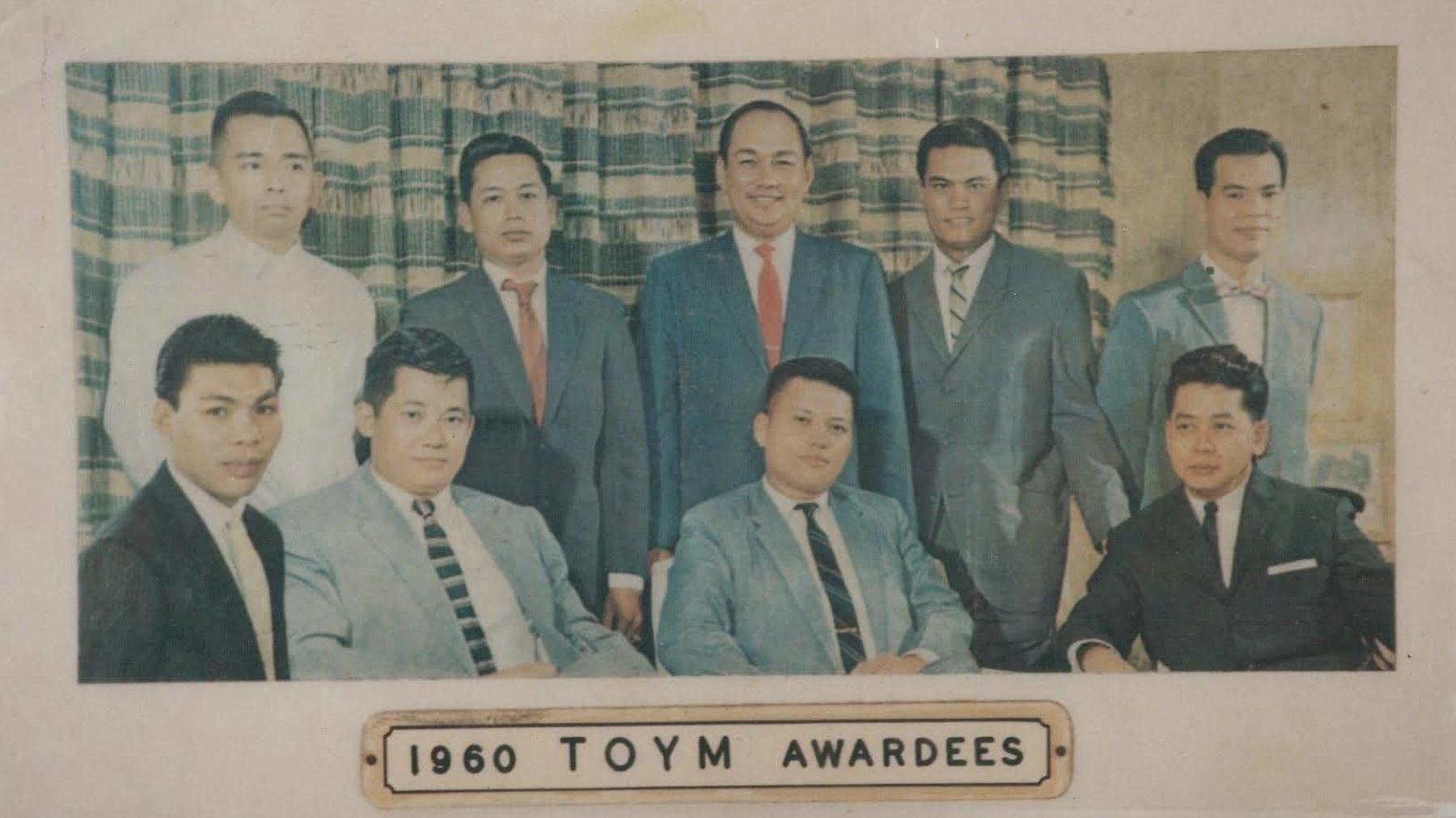Max Soliven (seated, 3rd from left) with boxer Gabriel “Flash” Elorde (1st from left) and journalist-politician Ninoy Aquino (2nd from left). Photo courtesy of Rogelio Medina
MY personal encounter with the late journalist Maximo V. Soliven began on August 2, 1990, the day Kuwait was invaded by Iraq. He told me to join him first in a morning breakfast at the lobby of Manila Peninsula hotel in Makati City before I interviewed him about his fond memories of Ninoy Aquino for the Philippine Daily Globe August 21, 1990 special focus feature entitled Ninoy, “The Men Who Remember Aquino.” (I actually got Max’s residence phone number through Ms. Mela Soliven-Pascual who I met during the birthday of Mother Socorro Reyes, former directress of St. Paul College of Manila, sometime in September 1989 at the house of Romy Reyes on breezy Acacia Street in Valle Verde, Pasig.)
Later Max brought me to the hotel’s La Bodega (now Nielsen) coffee shop where we saw then trade assistant secretary Gloria Macapagal-Arroyo who was taking a cup of coffee. Max right away introduced me to Gloria. As I shook her hand, I candidly said to her that she would be the country’s leader in the next millennium as Max smiled to what I was predicting. Gloria just smiled at me for she had no ambition to be president someday. But I was very sure that it would come true.
Meanwhile, I bade her goodbye for I had to interview Max Soliven, a multi-awarded journalist who remembered how Ninoy used to chide him for having started Ninoy’s career by firing Ninoy from The Guidon, the official weekly college organ of the Ateneo de Manila. Max was then the managing editor while Ninoy was a cub reporter.
Ninoy’s grammar then was awful, said Max, and “I told him, ‘Ninoy even if you improve your grammar, you don’t sharpen your mind.’ So he left The Guidon and joined The Manila Times.”
As an inspiring journalist, Ninoy’s grammar left much to be desired, said Max. But Ninoy had a keen eye and his guts were terrific, and he had what it took to be a successful newspaperman, the ability to detect what was newsworthy and to analyze the news, Max continued.
The editor of The Manila Times was so impressed with Ninoy that he would translate Ninoy’s dispatches into English, says Max, adding that it was only Ninoy’s copy that was edited by the editor-in-chief.
Interestingly, at 17, Ninoy Aquino became The Manila Times’ youngest war correspondent in Korea, a feat that had certainly made him famous.
“Malakas talaga ang loob ni Ninoy,” said Max. Ninoy was in fact given the Philippine Legion of Honor by then President Ramon Magsaysay, who was also very popular in the Philippines and abroad, for exemplary meritorious service to the Filipino people in negotiating the surrender of Huk Supremo Luis Taruc.
When martial law was declared, at about midnight of September 22, 1972, Ninoy was arrested at Manila Hilton Hotel. Then Manila Times columnist Max Soliven was picked up two hours later at his house in San Juan, shortly after receiving the Journalist of the Year award from the Manila Rotary Club.
“Eddie Ramos (who would later become President Fidel V. Ramos) was the one who rounded us up at Camp Crame. I asked him why I was arrested. Ramos said, ‘I don’t know; I just got the list that same night.’ Marcos was really funny. Earlier he told me he would give me the Legion of Honor. Two months later, he had me punished. I think that was the greatest honor Marcos gave me because he arrested me and made me a cellmate of Ninoy,” related Max.
Max further recounted how he enjoyed sharing Ninoy’s cell. “Ninoy was full of enthusiasm, he tried to cheer everybody up. When he entered prison, he was only superboy but after almost eight years in jail, he was superman. That Ninoy was a young man in a hurry was what they said about him before martial law. But incarceration clearly showed what kind of a man Ninoy was. When he was feeling discouraged, he would hide it. You would see courage there even when he was under tremendous pressure.”
Max also vividly remembered that he and Ninoy took charge of cleaning the toilet: “We divided assignments among ourselves. Ninoy was cleaning the toilet and he was very enthusiastic. Pinakintab ni Ninoy iyong toilet na iyan. Afterwards, it was shiny parang good housekeeping. He said to Chino Roces, ‘Wow! I have found my profession (as a janitor/toilet cleaner).’ And we all laughed together.”
One day, Marcos sent a group of psychologists to interview the political prisoners. Realizing that the interviewers were after their clinical profile, Max stood up and said, “Marcos can harass, torture and even shoot at us, but he cannot force us to send ours inside out so that he can look into our souls.” Max refused to be interviewed and walked out of the room. The others, with the exception of Ninoy, followed suit.
Only Ninoy Aquino agreed to be interviewed. Three hours later, Ninoy returned to their quarters and told them, “Ang galing ng mga psychologists na iyan. I answered their questions and they told me my character. They were right.” Then Max kidded Ninoy: “Now, Marcos knows everything about you inside out. How stupid can you be!”
Ninoy was laughing, recalled Max. “Ninoy said to me, ‘You’re the guy who started this story that the reason Marcos hates me is because I’m exactly like him, only younger. So, I wouldn’t be telling Marcos anything new.’ Ninoy was the kind of person who quickly made decisions – he wouldn’t wait for a month or a year, not even a week or a day. When he’s wrong, he would say, ‘Nagkamali ako, sorry ha? Problems never go away and if you can’t confront the problems today, tomorrow they would be worse.’ That was one thing that Ninoy told me. Ninoy had that down-to-earth, practical way of thinking.”
Max reminisced one midnight when Ninoy was taken away from the cell for an hour. When Ninoy came back, Max asked what they did to him. Ninoy couldn’t say anything, as the cell was bugged. When Max was about to be released, he asked Ninoy the same question. Ninoy replied, “They gave me a choice. If you sign this document supporting Marcos and martial law, you would be released at once. Of course, I refused to sign the document. I refused to recognize his dictatorship.”
If Ninoy were alive, Max said, Ninoy Aquino would make a great president.
At this point, my taped interview with Max Soliven that morning ended, and he promised that we would continue it next time.
True to his word, a few days before August 21 that year, I met him at Mandarin Oriental Hotel in Makati (thanks to Ms. Tess Santos, Manong Max’s able secretary). He was with Valeriano Bobit S. Avila (a Philippine Star columnist). I interviewed him this time for the Philippine Star’s “Pebbles” column of the late Betty Go-Belmonte (I pitched in for her on August 21, 1990).
As I sipped a cup of coffee inside the hotel’s cozy restaurant, Max reminisced that he sent messages to Ninoy in the U.S. five times a week. “Later, Lupita Aquino-Kashiwahara (wife of Ken Kashiwahara and younger sister of Ninoy) arrived in the country as a member of the advance party. I said to Lupita not to allow Ninoy to come home for he’s going to be assassinated. Five days after, Lupita and Doña Aurora came to my house (in San Juan) to deliver Ninoy’s final message to me.”
Ninoy’s message, said Max, was that “if he should die, then so be it. I hope that my death will awaken our people to stand up and fight for their rights.”
Max was really mad at Ninoy, so much so that he did not go to the airport in Parañaque that fateful August 21, 1983, a Sunday. “I knew in my heart that he was shot and was dead. I thought then, tapos na!”
But, he went straight to the Aquino home at 25 Times Street in Quezon City. Early in the morning, Ninoy’s bloodied body arrived at Times Street. Doña Aurora, Max recalled, said that she wanted her son to be put in the coffin exactly the way he arrived: “Don’t clean him up. I want the Filipino people to see what they have done to my son.” Cory was still in Boston and she would be flying back home later, together with her children.
Then Max looked at the coffin, and he saw his friends terribly bruised chin. He said, “Brod, talo tayo.”
Max started to cry. Later, he noticed a group of people, mostly street people like ballot vendors and newspaper boys, who did not know Ninoy personally.
Suddenly, Max said to Ninoy (in the coffin): “Baka we’ve not lost after all. That was actually the beginning of the mark of victory against the grave injustices and gross dictatorship of the Marcos regime. Eventually, Ninoy’s body was transferred to Santo Domingo Church to accommodate thousands of thousands of people who wished to pay their last respect to Ninoy.”
On August 31, 1983, about three million people from all walks of life joined the 10-hour funeral procession and braved the thunderstorm to be at Ninoy’s side. It was the first massive tidal surge of people power, spilling out onto the streets.
While on the street, Max recalled he was being interviewed by the Associated Press (AP), with regard to a comparison between the funeral march of Ninoy to that of President Ramon Magsaysay, who died in a tragic plane crash.
Max’s reply to the AP was this: “Well, we’re marching on different circumstances. The late President Magsaysay was buried as the president of the Republic of the Philippines so the crowd knew that there was no danger or risk. He was admired and proclaimed by the nation as their most beloved president. These people who are marching today are marching under the threat of arrest and possibly torture by Mr. Marcos and his goons. This is far more significant than the funeral of the late President Magsaysay (also a very dear friend of Max Soliven). More than 3 million people are walking today under the eyes of the troops of policemen and are shouting ‘Ninoy! Ninoy! Ninoy!’ That is when I feel that the dictatorship is doomed.”
Thank you very much Manong Max for having met you. Thank you for your generosity. I would always treasure the memory of knowing you and your friend Ninoy. You and your good deeds will live forever in my mind.






